#Designer Woven Fabric Manufacturer
Explore tagged Tumblr posts
Link
Woven Fabric Manufacturer in India - Response Fabrics
Woven Fabric Manufacturer in India
If you want to get the best Woven Fabric Manufacturer in India then Responsive Fabrics is one of the top well renowned manufacturers of a broad assortment of Woven Fabric, Upholstery Fabric, Mesh Fabric, Blackout Fabric, etc. The offered fabrics are woven at the well-developed manufacturing unit by making use of premium quality yarns, and threads in compliance with defined quality standards. The production department is well-furnished with ultra-modern machines, tools, and equipment to weave these fabrics.
Designer Woven Fabric Manufacturer
Responsive Fabrics has the best solution for the best selective variety of designer Woven fabric that is a delight to those who wear it as well as those who touch, and see it. The collection of woven fabric online gives the best look altogether. The threads used in our woven fabrics are durable, and fade resistant. This brings great joy for all the customers who buy cheap upholstery fabric from our online store & enjoy different benefits from these.
Woven PP Fabric Manufacturer
Response Fabrics is the top designer for woven fabric Manufacturers that offers the premium quality woven in various ranges that is known for its best quality, and at affordable prices. This is known to be the one of the popular associations occupied with giving brilliant quality material. The offered extent is unequivocally outlined & created utilizing premium quality fundamental material & advanced innovation. Additionally, we offer manufactured leather in various hues, and outlines according to the necessity of the customer at sensible costs.
Top 10 Global Non Woven Fabric Manufacturers
The top 10 Global Non Woven Fabrics Manufacturers includes- Berry Plastics, Freudenberg, Kimberly-clark, DuPont, Ahlstrom, Fitesa, Johns Manville, Glatfelter, Suominen Corporation, TWE.
Responsive Fabrics comes under the Top Brand For Woven Fabrics in India. This produces high quality\ world class products according to customer needs, and wants. The raw materials used are safe for your upholstery fabrics. These fabrics are alluring look, captivating pattern, smooth texture, flawless finish, tear resistant, colorfastness, and longevity.
READ MORE...Fabric Manufacturers In India - Response Fabrics
Artificial leather Manufacturers
Hospitality Fabric Manufacturers
Workstation Fabric Manufacturers
Office Chair Fabric manufacturers
Auditorium & Cinema Fabric Manufacturers
Acoustic fabric manufacturers
Antimicrobial Fabric Manufacturers
0 notes
Note
could you please tel us about some chairs with names
hi i'm sorry for not seeing this earlier! i mostly use tumblr on mobile and it hides the inbox from me.
so, most chairs have names! usually given to them by their designer or manufacturer, but for much older pieces it could be what they've become known as by historians. here are some of my faves:
the womb chair
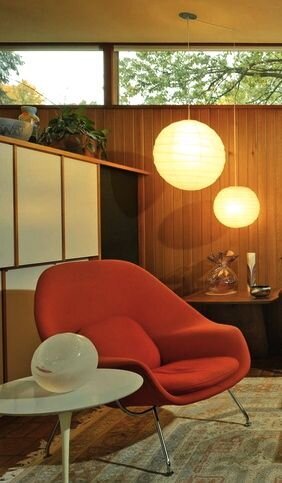
of course. the womb chair was designed by eero saarinen and manufactured by knoll (now by design within reach) and it is my very favourite chair in the whole world. incredibly comfortable and certifiably iconic (it was the first molded fiberglass chair), it was called the womb chair after Florence Knoll requested a chair she could "curl up" in. It's been enablng laziness since 1948.

the barcelona chair
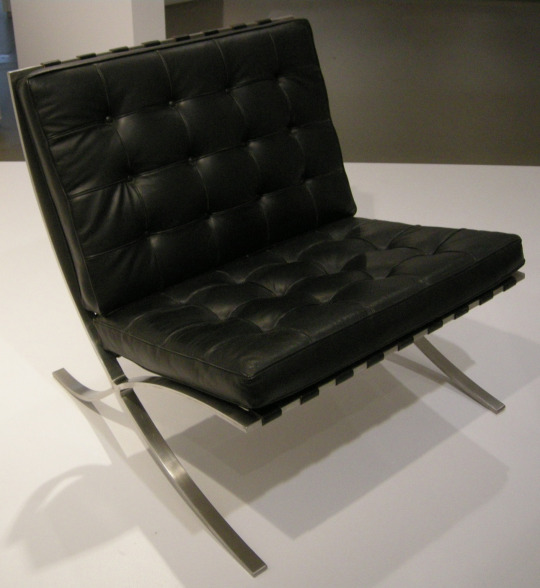
here's a name that is directly tied to the chair's origin: the barcelona chair was designed by ludwig mies van der rohe for the king and queen of spain to use within the german pavilion which mies designed for the 1929 World's Fair in Barcelona.
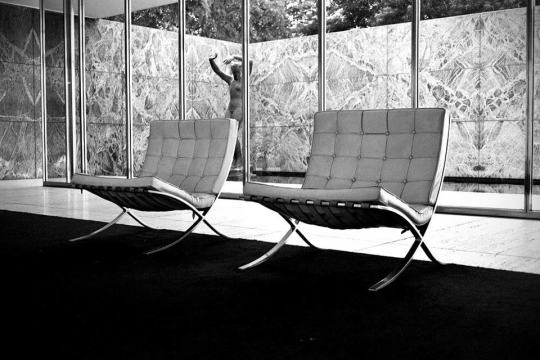

it was a hit, and the rest is history! the barcelona chair has been in almost constant production (also by knoll and then design within reach) ever since.
the sgabello

here's one where the name is a type of chair--the sgabello (this one is half of a pair in the national gallery of art, washington dc collection) was big in renaissance europe. designed to line hallways and be sat in for short periods of time (a comfortable seat this was not), sgabelli were usually constructed of walnut and elaborately carved. any chair of this form would be considered a sgabello--here's an earlier one with very different aesthetics in the collection of the met.

the butaque chair

finally, a chair which combines type and proper noun names. the butaque is a chair which came into use in colonial-era latin america, a hybrid of the spanish x-frame chair and pre-columbian duho. this specific butaque, which has come to be known as a proper-noun Butaque Chair, was designed by Cuban-born Clara Porset, who lived and worked in Mexico from 1935 on. She set out to learn more about the vernacular furniture in her adopted home, and came across the butaque. Her version emphasized ergonomics and local materials--the original (c. 1950) porset butaques are covered in wicker, leather, or locally woven fabrics.
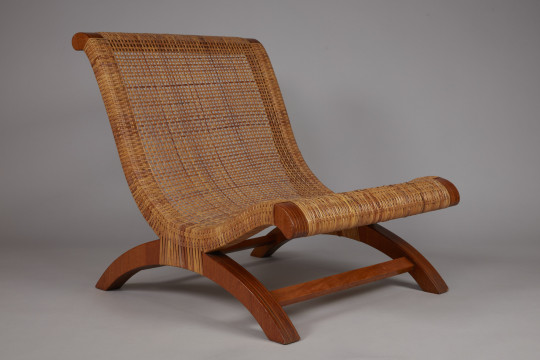
here's the one the moma has, which is covered in wicker.

and here's a photograph of porset's home.
i hope you enjoyed this taste of chairs with names! i encourage you to look up the furniture/decorative objects you love the most--they probably have names, too :)
1K notes
·
View notes
Note
Would you ever consider restocking a retired design via a trusted third party seller? I only just discovered your store and there's so many designs I missed out on that I absolutely adore, and I know you said you don't really plan to restock personally anytime soon.
i'm really glad you like our previous designs! unfortunately doing this is not nearly as easy as it sounds. it would also cause confusion because people would be expecting the same product and would not receive it, since if we tried to make more of our midi skirts thru another brand or print on demand service, it wouldn't be going thru our manufacturer with our specs.
i hate to do this because i feel like it sounds snobbish, but if you have one of our skirts from our current manufacturer and another product from a print on demand service or from a brand similar to ours, i want you to look at the quality and construction in the sewing, the detail in the printing, and how tightly knit or woven the fabric is. are all the edges finished? are seams sewn correctly or are they crooked? are the insides of the pockets printed and, if not, can you see the unprinted pockets when the garment is being worn? does the garment pill in the wash? are the seams loose, do they fall apart after a few wears or a few times being washed? was this garment sewn well? was it sewn to last?
and, on top of all of that, was the garment made in a factory that was certified for ethical labor?
if we licensed someone else to make our exact same products but using their production means, we could very easily just end up devaluing our own products.
57 notes
·
View notes
Text
on friday I decided I wanted to make better luggage bags for my wheelchair in time for my trip today (monday), so I spent the weekend in a frenzy and created these
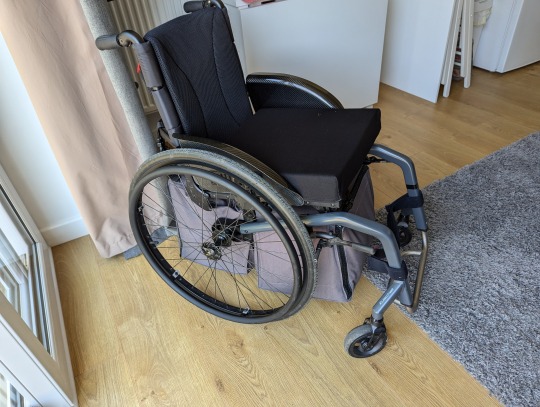
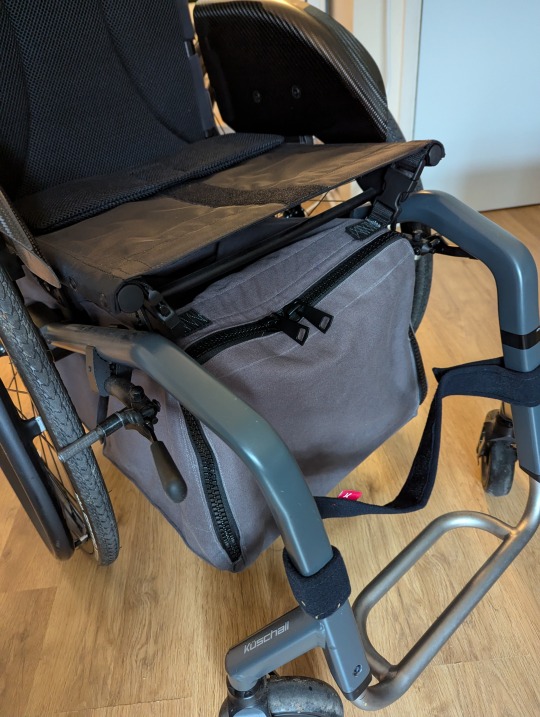
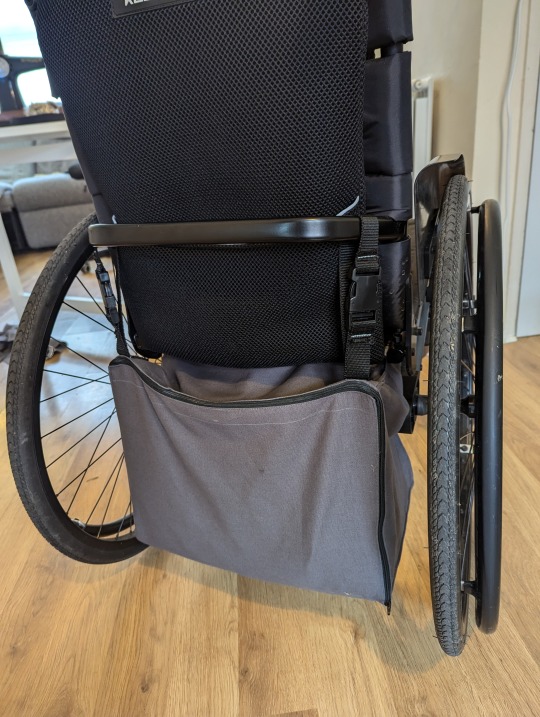
lots more pics and info under the cut!
until now I've been using an off-the-rack under seat bag at the front (smaller than necessary, awkward to use) and random shopping bags bungeed to the axle at the back (impossible to add/remove items without taking them off and unpacking them entirely, not much volume for all that effort).
here's my old setup for comparison (although I can still add the backpack with the new setup too):

the old front bag attached by wrapping all the way over the seat, which made it difficult to remove. it was also unnecessarily small - there was a lot of wasted spare space behind and either side of it.
I measured up for a replacement to properly fill the available space. It's a simple but irregular cuboid - the top edge slopes slightly (because the seat slopes), and the top is narrower than the bottom (becase the frame is in the way at the top).
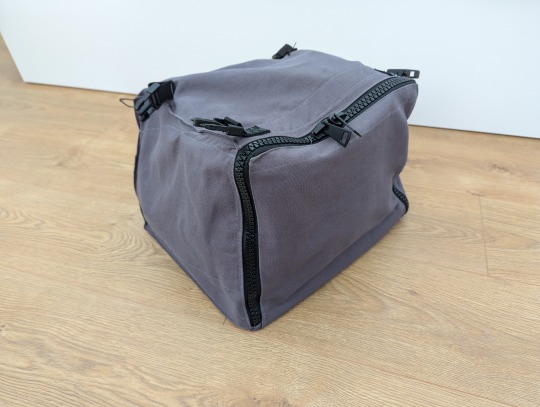
I designed mine to attach directly to the frame, rather than around the seat. at the back there are short straps with side-release buckles to wrap around a conveniently-placed bar on the frame. at the front are more side-release buckles, attached to make use of the buckles that were installed on the chair by the manufacturer (intended to attach a much smaller under seat bag).
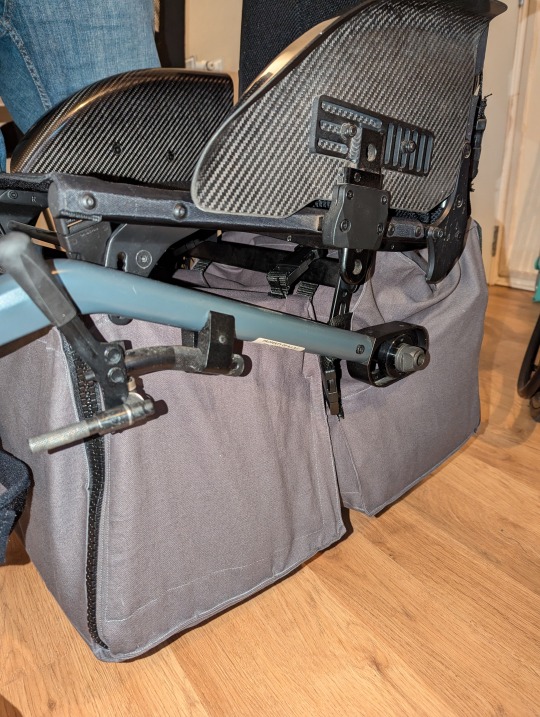
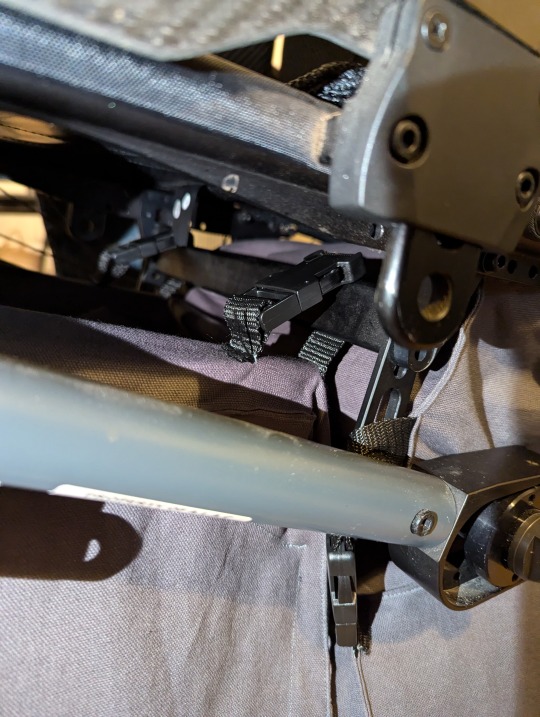
the old bag just had one big compartment inside, so there was no easy way to keep small items accessible without them getting lost among everything else. so I added pockets to mine!
at the top, I made a panel the whole size of the top face, and attached it at a slight diagonal to make a shallow sloping pocket. I also added big flat patch pockets to both sides. and I added a piece of really thick cardboard as a base shaper so it wouldn't sag when full of stuff.

the rear bag was a lot more complicated. I didn't have an existing bag for this use at all, I'd been getting by with just bungeeing soft bags onto whatever bars I could reach on the frame.
I took a bunch of measurements and planned out my design. to make the best use of the space, it needed to wrap *around* the axle both above and below. so the end result is a slightly irregular cuboid but with a cutout at one side.
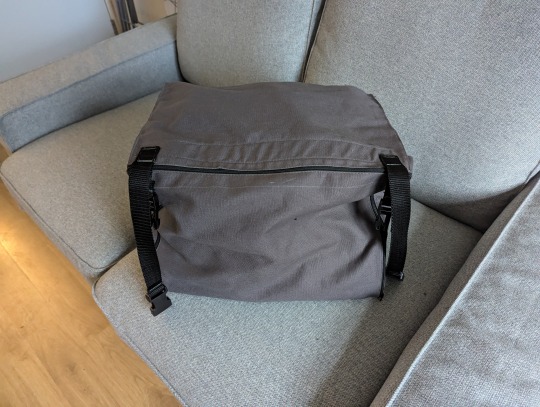
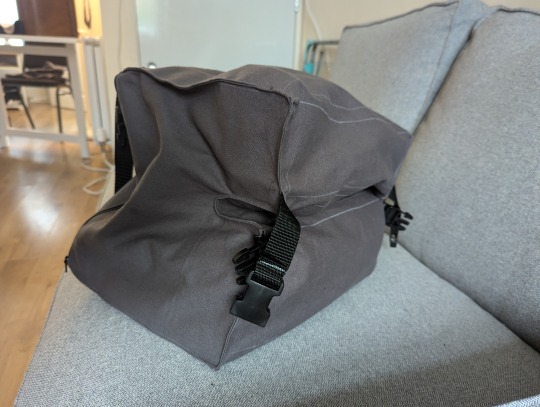
just above the axle cutout, there are short straps which clip around side bars on the frame to keep it in place. at the other end there are longer straps which buckle around the horizontal bar on the seat backrest, to hold it up.
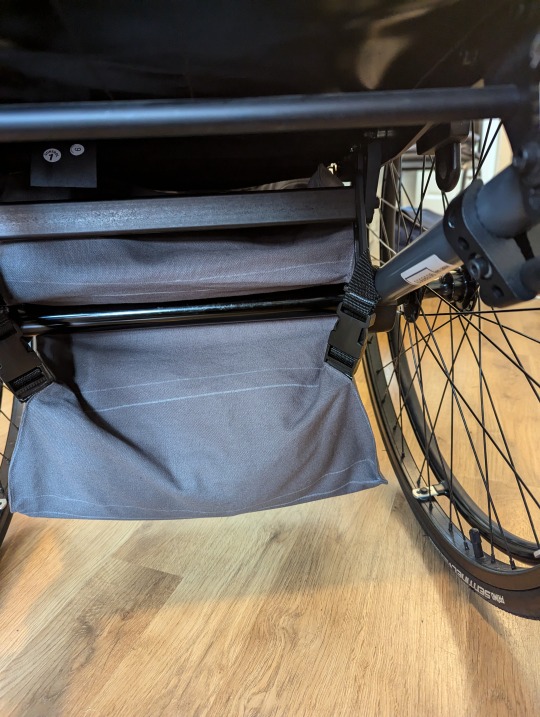
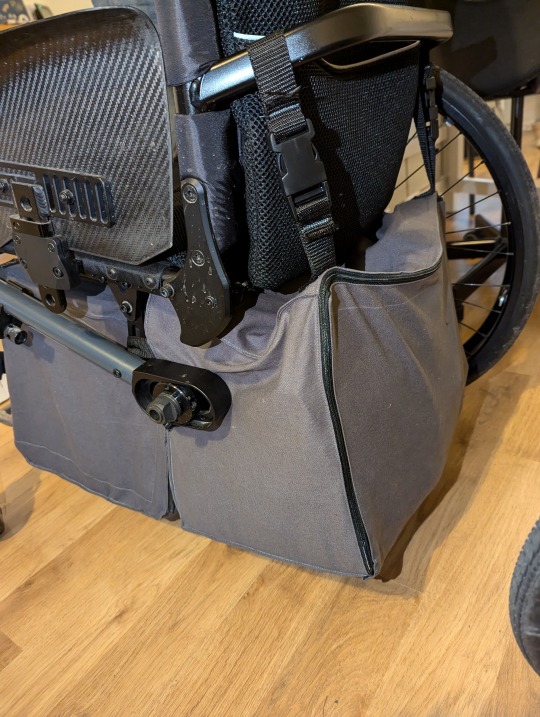
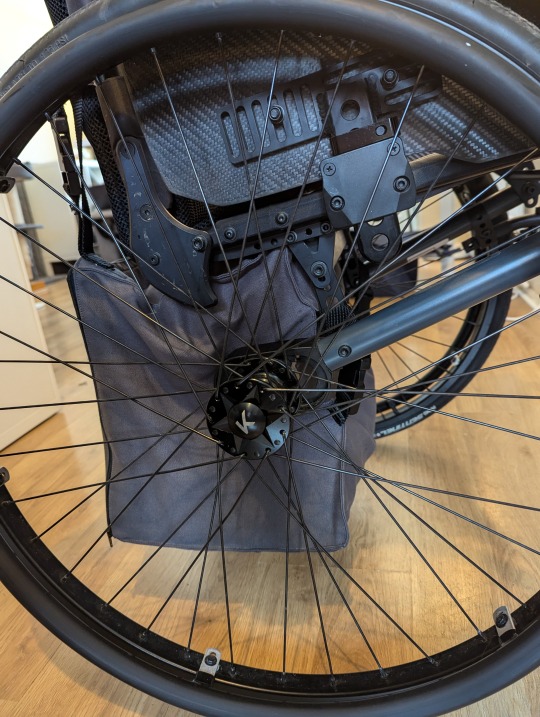
I didn't add any pockets to this bag, because it's basically for luggage so I won't need to get at small things while it's still attached. more board in the bottom to keep the base in shape.
I would have used a double-ended zip for this one too but I couldn't get one in time (might replace it later). I'm also wondering about adding a shelf or something, to make it easier to squeeze things into the little above-axle space without falling back out.
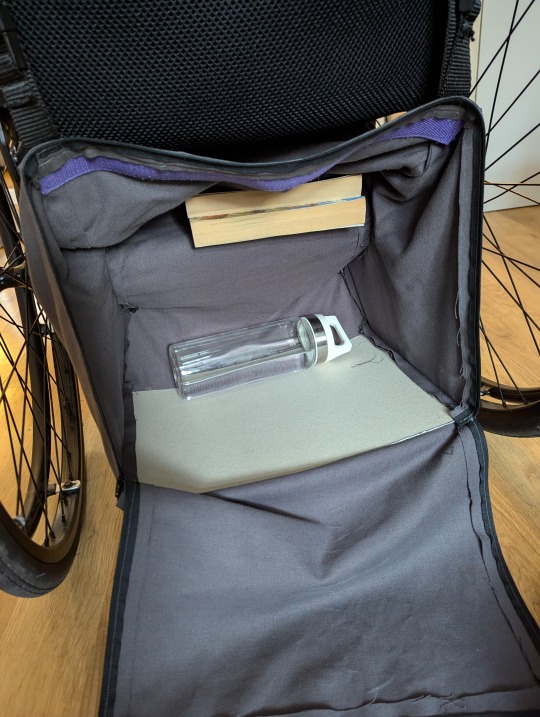
on both bags I added a strip of old woven belt along the inside top of the opening, to help it keep its shape when the zip is undone.
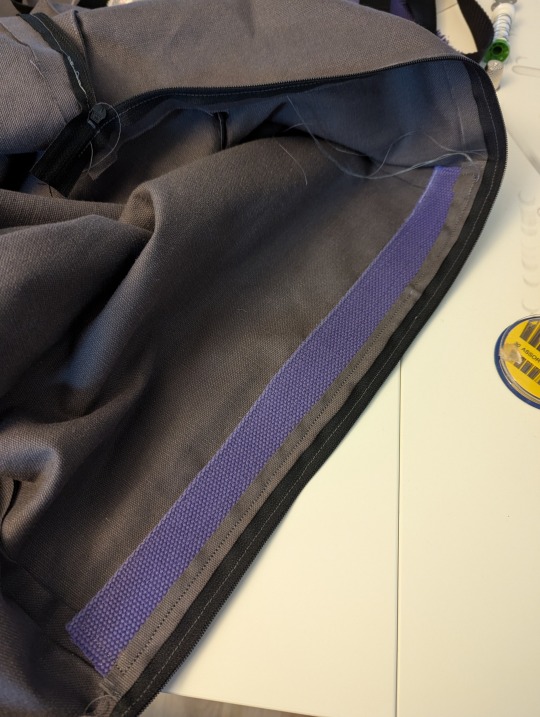
I don't know enough sewing vocabulary to describe the kind of seam I used on them, but- I folded the edges in, right-sides together, and then topstitched over them. just one line of stitching per seam, but that line goes through each piece of fabric twice. raw edges still exposed on the inside.
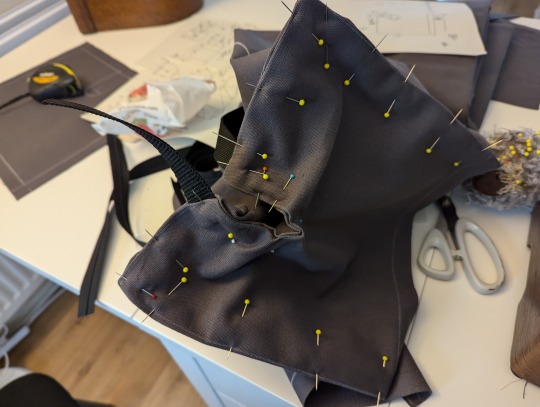
I successfully took the new bags on a 4.5-hour train journey today, packed with a week's worth of luggage. and when I arrived, all I had to do was clip them off the chair and lay them on their backs, and then they can easily unzip like suitcases!
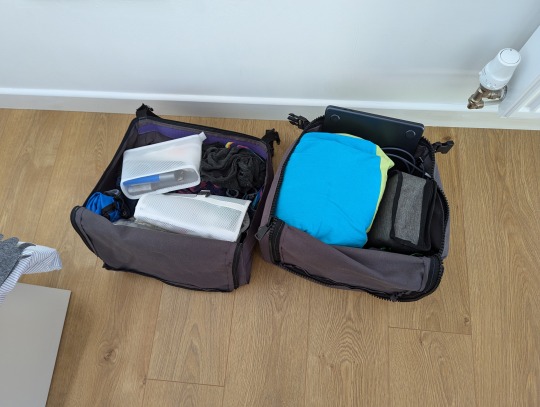
56 notes
·
View notes
Text
"Growing flax to make linen was one of the oldest human activities in Europe, particularly in the Rhineland. Archeologists have found linen textiles among the settlements of Neolithic cultivators along the shores of Lake Neuchâtel in the Jura Mountains west of Bern, Switzerland. These were elaborate pieces: Stone Age clothmakers of the Swiss lakeshores sewed pierced fruit pits in a careful line into a fabric with woven stripes. The culture spread down the Rhine and into the lowland regions.
The Roman author Pliny observed in the first century AD that German women wove and wore linen sheets. By the ninth century flax had spread through Germany. By the sixteenth century, flax was produced in many parts of Europe, but the corridor from western Switzerland to the mouth of the Rhine contained the oldest region of large-scale commercial flax and linen production. In the late Middle Ages the linen of Germany was sold nearly everywhere in Europe, and Germany produced more linen than any other region in the world.
At this juncture, linen weavers became victims of an odd prejudice. “Better skinner than linen weaver,” ran one cryptic medieval German taunt. Another macabre popular saying had it that linen weavers were worse than those who “carried the ladders to the gallows.” The reason why linen weavers were slandered in this way, historians suspect, was that although linen weavers had professionalized and organized themselves into guilds, they had been unable to prevent homemade linen from getting onto the market. Guilds appeared across Europe between the twelfth and fifteenth centuries but many of the items they produced for exchange, like textiles and soap, were also produced at home right up through the nineteenth century. The intricate regulations of the guilds—determining who could join, how they would be trained, what goods they would produce, and how these could be exchanged—were mainly designed to distinguish guild work from this homely labor. That linen making continued to be carried out inside of households—a liability for guilds in general—lent a taint to the linen guild in particular.
In the seventeenth century, guilds came under pressure from a new, protocapitalist mode of production. Looking for cheaper cloth to sell on foreign markets, entrepreneurs cased the Central European countryside offering to pay cash to home producers for goods. Rural households became export manufacturing centers and a major source of competition with the guilds. These producers could undercut the prices of urban craftsmen because they could use the unregulated labor of their family members, and because their own agricultural production allowed them to sell their goods for less than their subsistence costs.
The uneasiness between guild and household production in the countryside erupted into open hostility. In the 1620s, linen guildsmen marched on villages, attacking competitors, and burning their looms. In February 1627 Zittau guild masters smashed looms and seized the yarn of home weavers in the villages of Oderwitz, Olbersdorf, and Herwigsdorf.
Guilds had long worked to keep homemade products from getting on the market. In their death throes, they hit upon a new and potent weapon: gender. Although women in medieval Europe wove at home for domestic consumption, many had also been guild artisans. Women were freely admitted as masters into
the earliest medieval guilds, and statutes from Silesia and the Oberlausitz show that women were master weavers. Thirteenth-century Paris had eighty mixed craft guilds of men and women and fifteen female-dominated guilds for such trades as gold thread, yarn, silk, and dress manufacturing. Up until the mid-seventeenth century, guilds had belittled home production because it was unregulated, nonprofessional, and competitive. In the mid-seventeenth century this work was identified as women’s work, and guildsmen unable to compete against cheaper household production tried to eject women from the market entirely. Single women were barred from independent participation in the guilds. Women were restricted to working as domestic servants, farmhands, spinners, knitters, embroiderers, hawkers, wet nurses. They lost ground even where the jobs had been traditionally their own, such as ale brewing and midwifery, by the end of the seventeenth century.
The wholesale ejection of women from the market during this period was achieved not only through guild statute, but through legal, literary, and cultural means. Throughout the sixteenth and seventeenth centuries women lost the legal right to conduct economic activity as femes soles. In France they were declared legal “imbeciles,” and lost the right to make contracts or represent themselves in court. In Italy, they began to appear in court less frequently to denounce abuses against them. In Germany, when middle-class women were widowed it became customary to appoint a tutor to manage their affairs. As the medieval historian Martha Howell writes, “Comedies and satires of this period…often portrayed market women and trades women as shrews, with characterizations that not only ridiculed or scolded them for taking on roles in market production but frequently even charged them with sexual aggression.” This was a period rich in literature about the correction of errant women: Shakespeare’s The Taming of the Shrew (1590–94), John Ford’s ’Tis Pity She’s a Whore (1629–33), Joseph Swetnam’s “The Araignment of Lewde, Idle, Froward, and Unconstant Women” (1615). Meanwhile, Protestant reformers and Counter-Reformation Catholics established doctrinally that women were inherently inferior to men.
This period, called the European Age of Reason, successfully banished women from the market and transformed them into the sweet and passive beings that emerged in Victorian literature. Women accused of being scolds were paraded in the streets wearing a new device called a “branks,” an iron muzzle that depressed the tongue. Prostitutes were subjected to fake drowning, whipped, and caged. Women convicted of adultery were sentenced to capital punishment.
As a cultural project, this was not merely recreational sadism. Rather, it was an ideological achievement that would have lasting and massive economic consequences. Political philosopher Silvia Federici has argued this expulsion was an intervention so massive, it ought to be included as one of a triptych of violent seizures, along with the Enclosure Acts and imperialism, that allowed capitalism to launch itself.
Part of why women resisted enclosure so fiercely was because they had the most to lose. The end of subsistence meant that households needed to rely on money rather than the production of agricultural goods like cloth, and women had successfully been excluded from ways to earn. As labor historian Alice Kessler-Harris has argued, “In pre-industrial societies, nearly everybody worked, and almost nobody worked for wages.” During the sixteenth and seventeenth centuries, monetary relations began to dominate economic life in Europe. Barred from most wage work just as the wage became essential, women were shunted into a position of chronic poverty and financial dependence. This was the dominant socioeconomic reality when the first modern factory, a cotton-spinning mill, opened in 1771 in Derbyshire, England, an event destined to upend still further the pattern of daily life."
- Sofi Thanhauser, Worn: A People's History of Clothing
#radical feminism#feminism#linen#history of clothing#sexism#female oppression#the rights they TOOK from us#i'm so pissed#i knew there would be misogyny in history of clothing#but this made my blood burn#Sofi Thanhauser
96 notes
·
View notes
Text
you've probably seen this zigzag trim called ricrac/ rick rack, especially if you do craft supply thrifting or work with vintage materials (or grew up between the 1950s & 1980s).

(image from a 2022-23 article touting a rick rack revival)
✨️🧵🪡 Did you know rick rack was invented in the 1860s? 🧵🪡✨️
First known as “waved crochet braid” (catchy huh?), rick rack first appeared in the 1860’s but didn’t take on its modern form or name until around 1880. During the 1890’s rick rack sewing trim was imported for use by American sewists as a decorative edging for dresses, aprons, and lingerie. It was also incorporated into lace and then used to decorate curtains, bedding, and other home linens.
After a brief slump in popularity, rick rack ribbon once again came into vogue during the 1910’s when American manufacturers began to produce it. One of these was William E. Wright & Sons, which was founded in Massachusetts in 1897.
Cotton rick rack was in high demand from the 1930’s through the 1950’s when home sewists were upcycling cotton sacks used to pack commodities such as flour, cornmeal, and livestock feed to make dish towels, aprons, and clothing for their families. Wrights rick rack was prized because it was durable; it would tolerate rigorous laundering. The many choices of Wrights rick rack colors complimented the bright flour sack prints. Adding a bit of rick rack helped alleviate the stigma of having to use the feed sack fabric that was available.
After another lull during the 1960’s, rick rack experienced a resurgence of popularity during the 1970’s thanks to Laura Ingalls’ influence. But rick rack hasn’t ever really gone out of style, and it is available in a rainbow of currently popular colors.
(Missouri Star Quilt Co. on Wright's Rick Rack)
more interesting details on early-20th-C history, from Wikipedia...
During the 1910s, rickrack experienced a resurgence in popularity, and American manufacturers began producing rickrack to supply to the domestic market. Among other uses, this rickrack was incorporated into crocheted lace. Books of designs, such as Nufashond Rick Rack Book, helped to popularize the craft.
In rural America in the 1930s, 1940s, and 1950s, rickrack was used to decorate feed sack dresses. These dresses were worn as everyday attire, and were constructed from the large cotton bags that flour, chicken feed, and other goods were shipped in. Since the food had to be shipped in fabric bags anyway, the flour mills competed with each other by using attractive, colorful fabrics that the buyer could either resell or upcycle into dresses, aprons, nightgowns, dishtowels, and other clothing and household items. Adding trim like rickrack was a way to reduce the stigma around needing to use whatever fabric was available, rather than buying it from a store.
I fell down this rabbit hole when I saw Anna wearing this hat in the early 1920s of Downton Abbey s3:

though on closer examination I see that her hatband accent is not actually ricrac, but rather velvet ribbon woven into a ricrac-style zizag pattern. given Downton's notorious attention to historical set & costume detail, & ricrac's contemporary popularity, I wonder if more "fine family" types & their staff picked up the visual trend in higher quality materials. Very cool!
15 notes
·
View notes
Text

Moi-même-Moitié has brought back their high socks without lace! Great timing because I need socks like this for winter. So of course I bought Rose Diamond High Socks in the three colorways.
Moi-même-Moitié がレースなしのハイソックスを復活させました。冬にはこういう靴下が必要だったので、素晴らしいタイミングでした。ということで、もちろんローズダイヤモンドハイソックスを3色購入しました。

Honestly, the vintage Moi-même-Moitié that I wear more than anything else is the high or knee socks. Because they are great with skirts, dresses and especially pants. And yes I have a pair of the original Rose Diamond Socks.
正直に言うと、私が何よりもよく履いているヴィンテージの Moi-même-Moitié は、ハイソックスまたはニーソックスです。スカート、ドレス、特にパンツとよく合うからです。そして、はい、私はオリジナルのローズダイヤモンドソックスを一足持っています。

In comparison, the new version, on the right, is longer and a little bigger than the vintage socks. But not too much bigger. With the stretch, some men can even wear these. I don't know what the material is for the vintage socks. The new version is 80% cotton, 18% nylon and 2% polyurethane. Cotton with nylon is a good combination for comfort. The new version knit feels a little thicker than the vintage socks.
それに比べて、新しいバージョンはヴィンテージ ソックスより長く、少し大きめです。でも、大きすぎるということはありません。ストレッチが効いているので男性でも着用できる方もいると思います。ヴィンテージソックスの素材は分かりません。新しいバージョンは綿 80%、ナイロン 18%、ポリウレタン 2% です。綿とナイロンの組み合わせは着心地が良いです。新しいバージョンのニットはヴィンテージソックスよりも少し厚いように感じます。

The bands at the tops of both socks are similar, with the new socks having a bit of scalloping at the top. Both stretch and seem to be good at holding your socks up when worn.
両方のソックスの上部のバンドは似ていますが、新しいソックスには上部に少し波形があります。どちらも伸縮性があり、履いたときに靴下を持ち上げるのに適しているようです。

The Rose Diamond design is similar for both versions. It is woven in the sock and can be felt inside but the fabric is soft. This is better than printed on, which can wear off over time. The design on the vintage socks is a little bigger, but the size difference could be due to changes in manufacturing. The blue color is really close to the vintage blue!
Overall I can say the new Rose Diamond High Socks are comparable to the 2007 version and are really nice. I look forward to wearing them when the weather is colder. My experience with Moitié socks is they hold up well, even when going to multiple Moi dix Mois live shows.
ローズ ダイヤモンドのデザインはどちらのバージョンでも似ています。ソックスに織り込まれていて、内側で感じられますが、生地は柔らかいです。これは、時間の経過とともに擦り切れてしまうプリントよりも優れています。ヴィンテージ ソックスのローズ ダイヤモンド デザインは少し大きめですが、サイズの違いは製造方法の変更によるものかもしれません。ブルーの色はヴィンテージ ブルーにとても近いです!
全体的に見て、新しいローズ ダイヤモンド ハイ ソックスは 2007 年バージョンに匹敵し、本当にニース だと言えます。天気が寒くなったら履くのが楽しみです。Moitié ソックスの私の経験では、Moi dix Mois のライブ ショーに複数回行っても、しっかり持ちこたえることができました。
6 notes
·
View notes
Text
Prints and Patterns
A light on Prints & Patterns.
The patterns on a fabric just put colors on are definitely not woven into fabric. called Prints. These are found in several types like, customized shapes, colors, lines, etc. and in the form of objectives as well. The work of art made in multiple iterations, created through a transfer process. The word “Print” is derived from the Old French word for “Impression,” it makes a product look different from its own origin. It has the power to grasp the attention of someone towards it. When prints and patterns work together it gives a hard on its final project. Nowadays, people are using most commonly made from an acrylic polymer.
Why are Prints important?
Printing is used not merely for books and newspapers but as the time flies it is also used for textiles, plates, wallpaper, packaging, and billboards. Several studies have concluded that people simply absorb content better when it's presented on a page, rather than a screen. This is why some college students are reluctant to use PDF versions of their textbooks; reading printed material somehow allows for higher brain function and better information retention. These designs can be simple or super detailed, but they all have the same goal: to make the fabric look even more amazing! Due to some eye-catching prints and patterns, clothes become more appealing to customers, grabbing their attention and making them want to take a closer look. Printing on fabric plays a crucial role in the fashion industry, being a method for applying designs, patterns, or images to fabrics. Textile printing offers a wide range of design options, allowing clothing manufacturers to create a variety of unique Styles, Prints and Patterns, and Colors of Fashion.

Why are Patterns important?
In the garment industry, patterns are used in order to cut the fabric pieces and to make the garment. Patterns are essentially made so that the same style can be easily duplicated when it is needed and multiple pieces can be efficiently made. Improved quality: Patterns can help to ensure that garments are made to the desired specifications, which can lead to improved quality and customer satisfaction. Prints and Patterns making is the process of creating a blueprint of your garment. A pattern is used as a template to cut out fabric that matches the required specifications to sew a garment. Its factors in the type of fabric, the intended fit on the wearer, and any trims that will be used. Prints and Patterns on a fabric makes a plain to be creative.
Final product as printed fabric?
Generally, the finishing process includes three basic stages: washing and drying, stabilizing, and pressing. In addition, some fabrics are then treated to make them anti-static, water repellent, or flame retardant. Many methods applied to fabrics in these stages are very specialized and we can't discuss them all. Definitely, after applying Prints and Patterns on chic indicates customization of fabric then that fabric is processed further for next processes like cutting and stitching.
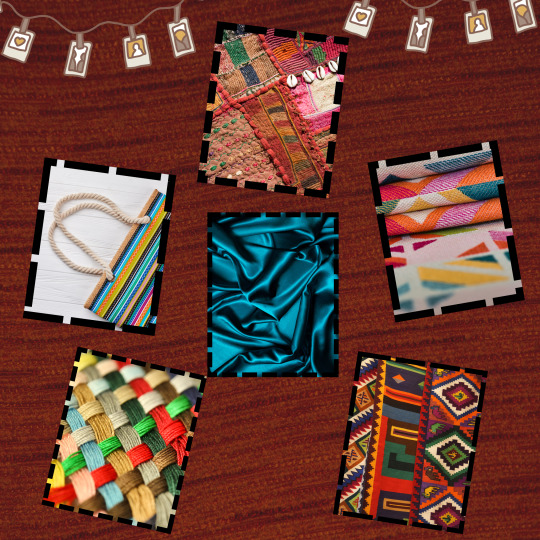
Addition of Tie & Dye in fabric:-
Tie & Dye is a term used to describe a number of resist dyeing techniques and the resulting dyed products of these processes. The process of tie-dye typically consists of folding, twisting, pleating, or crumpling fabric or a garment, before binding with string or rubber bands, followed by the application of dye or dyes. Textile printing is the process of applying color to fabric in definite prints and patterns or designs. In properly printed fabrics the color is bonded with the fiber, so as to resist washing and friction. In golden era, people were using natural objects to paint the garments i.e. Leaves, Vegetables, Stones, etc. Nevertheless, Tie and Dye fabrics are included in Rajasthani cultural traditions. Moreover, due to Social media, people are connecting globally and sharing their ideas of painting, prints and patterns to give an elegant look to their final outfits.
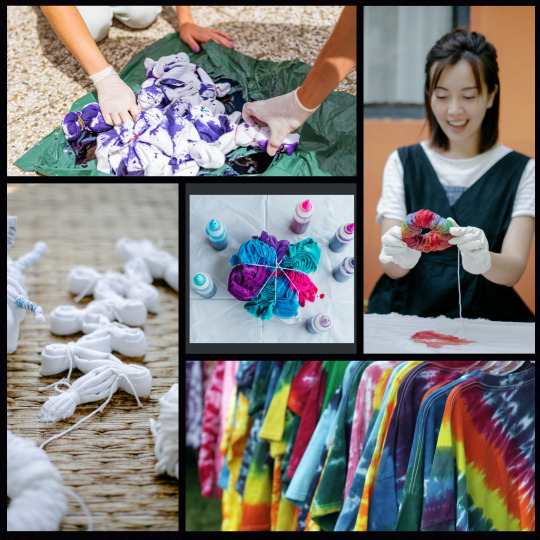
Prints and its historical background:-
Printing blocks have been discovered that date back to around 3000 B.C." Fabric painting remained popular on the continent, and by the time Alexander the Great invaded India (327 B.C.), fabrics full of colorful printed and painted images were a normal possession among the people. There are several thighs to disclose about the past of prints but our main topic is just for the usage of prints and patterns.
Motifs and Prints:-
A motif is a repeated idea, pattern, image, or theme. In the textile arts, a motif is also called a block or square which is a smaller element in a much larger work. Motifs can be any size, but usually all the motifs in any given work are the same size. There are types of motifs which are defined as:
Symbolic Motifs: These motifs take the form of symbols that represent a larger idea or theme.
Conceptual Motifs: These motifs are built around a particular concept or idea that recurs in the story.
Structural Motifs: These motifs are repeated patterns or structures in the story.

Types of Prints in fabric:-
There are several types of the prints and patterns in the fabric but the majorly are in used are mentioned ahead:-
Boho Prints:- Boho style is a free-spirited aesthetic that mixes different cultures and artistic expressions into an eclectic style with an emphasis on organic elements and nature. When putting together your boho style space, mixing patterns, metals, woods, materials, animal hides and trinkets from your travels is highly encouraged.

Screen Prints:- Screen Printing is a process where ink is forced through a mesh screen onto a surface. Making certain areas of the screen impervious to printing ink creates a stencil, which blocks the printing ink from passing through the screen. The ink that passes through forms the printed image.
Block Printing:- A printing block is sometimes called a printmaking block, a wood block or a block. You can also refer to one simply as a printing block.

Animal Printing:- Animal print is a clothing and fashion style in which the garment is made to resemble the pattern of the skin and fur, feathers or scales of animals such as a leopard, zebra, giraffe, tiger or cow.
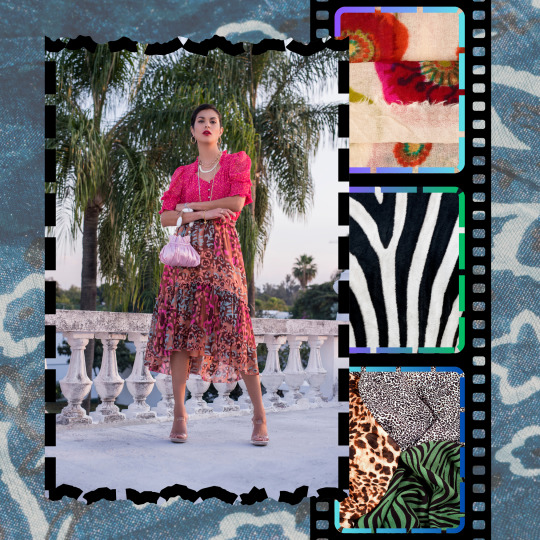
Batik Prints:- Batik is an Indonesian technique of wax-resist dyeing applied to the whole cloth. This technique originated from the island of Java, Indonesia. Batik is made either by drawing dots and lines of wax with a spouted tool called a canting, or by printing the wax with a copper stamp called a cap.

Rest there are several prints and patterns which can be used by us, on a daily basis but we are not aware about it. But we should know which prints are suitable for your eyes and your comfort. Rest we are always here to help you out and provide you best opinion as always.
#fashion#fashion designer#fabric#denim#accessories#fashion trends#haute couture#fashion blog#fashion inspiration#prints#art print#printmaking#artwork#art#artists on tumblr#my art#illustration#drawings#tie dye#dyeing#cotton#upcycling#bohochic#bohemian#batik#floral#flowers#roses#plants#garden
6 notes
·
View notes
Photo

Engineers weave advanced fabric that can cool a wearer down and warm them up
Textile engineers have developed a fabric woven out of ultra-fine nano-threads made in part of phase-change materials and other advanced substances that combine to produce a fabric that can respond to changing temperatures to heat up and cool down its wearer depending on need.
Materials scientists have designed an advanced textile with nano-scale threads containing in their core a phase-change material that can store and release large amounts of heat when the material changes phase from liquid to solid. Combining the threads with electrothermal and photothermal coatings that enhance the effect, they have in essence developed a fabric that can both quickly cool the wearer down and warm them up as conditions change.
A paper describing the manufacturing technique appeared in ACS Nano on August 10.
Many occupations, from firefighters to farmworkers, involve harsh hot or cold environments. Cold storage, ice rinks, steel forges, bakeries, and many other job sites require workers to make frequent transitions between different and sometimes extreme temperatures. Such regular temperature changes are not only uncomfortable but can cause illness or even injury, and require a cumbersome constant change of clothing. A sweater will keep a worker warm in a cold meat locker, but could overheat the same worker when they leave that space.
Read more.
#Materials Science#Science#Textiles#Clothing#Smart materials#Phases#Nanotechnology#Electrothermal#Photothermal#Coatings#Electrospinning#Fibers#Polymers#Phase change materials
104 notes
·
View notes
Text

Title: Stay
Chapter: 4/6
Pairing: Ezra x f!Reader, Ezra x you (Reader is addressed by 'you' or nickname)
Rating: 18+, smut in chapter 6
Content: Situationship to romance, soft Ezra, intimacy, loss of limb (non-explicit), canon compliant
Summary: When you've almost given up waiting for him, a certain prospector returns to the Pug to call in a favor...
Ao3: complete fic
《 chapter 3 chapter 5 》

Chapter IV
Ezra’s health steadily improves over the following cycles. So does his connection to Cee. More often than not you find them immersed in their respective reading, side by side on your worn couch, or discussing the novels that keep them busy.
You hadn’t even known there was a library within walking range of your complex. You were told it was by no means large and consisted mostly of questionable survival guides for the odd floater prone to reading. But it hadn’t taken Cee long to sniff out a small section of old novels, idly gathering dust on a neglected corner shelf.
Ever since Cee disclosed her secret lair of entertainment to curious Ezra, the two of them occasionally vanish for walks and return with a new stack of reading material.
Each time you see them come in and witness the girl’s carapace of wariness thaw further, a content warmth settles within you. Their encounter, out in the Green, was nothing but a long string of unfortunate circumstances, tightly wrapped in the moon’s overall perilous conditions. There was no turning back time. No taking back rash and questionable decisions on either side.
Still, they make it work, oscillating between forgetting and forgiving what can’t be undone – somehow saving each other from falling prey to the lurking spiral of debilitating ‘what if’s’.
Whilst they tentatively form their bond, you are more focused than ever. Measurements taken cycles prior, you ceaselessly work on Ezra’s prosthesis. And when he’s not out and about with Cee or poring over shared literature, he’s by your side and shamelessly nosey. While he certainly insisted on off-the-shelf design and basic functionality, you’re adamant on making it from scratch. A service you barely exercise with the clientele of mostly mineworkers from the belt or the unluckiest of prospectors.
You delight in it. In creating shapely, reliable prostheses. In fabricating something that increases the quality of life in each aspect. You want him to feel good with it – and safe. So you pour your entire passion into the task and slowly but surely manufacture a prosthesis, that is him, in any possible sense.
“Why don’t you join us?”
Cee’s question breaks your concentration. You had been so preoccupied by your work, that you nearly missed them leaving. Now Cee stands by the door and eyes you expectantly. Guessing by the stack of three novels in her arms, they’re about to move out on another run for the library.
You eyes flicker back to the elbow joint in your hands, almost ready to be attached to the forearm’s base.
“I ain’t gonna regrow a limb, Patches,” ribs Ezra, “No need to rush.”
He’s got a point, as nasty as that truth tastes. And… even though you won’t admit that out loud, as long as you’re working on the replacement for his arm, he might be inclined to share your quarters for a tad longer. As much as you want to help him get back on his own feet, that thought is tempting. You can’t deny it hasn’t crossed your mind before, mingling with the persistent yearn for his closeness. You’ve adamantly pushed it away, woven those pestering emotions into your drive to work. But now that he's suggesting you to shift down a gear…
“Alright, gimme a sec.”
From the corner of your eye you watch his growing smirk. Somewhat satisfied with hint of relieve. As you set your work aside and slip your arms into the sleeves of your jacket, you wonder if he feels guilty for accepting your help. What you offer has certainly outgrown a simple ‘favor’. Out in the harshness of the Frontiers, Ezra takes what he gets, no questions, no remorse. He’s not one to doubt his actions. You’ve seen him ravage with little care for his kind. But around the girl, around you, a softness surfaces that you adore.
A softness that shines in the warmth of his eyes when you step outside with them. Sometimes you wonder what kind of man he would have been if he hadn’t been abraded by the roughness of the system’s fringes. A merchant, maybe? An author? Your mind paints a picture of him wielding a pen like wields his thrower. As daring as he’s proficient. You’d have succumbed to his charms all the same.
A stupid, happy smile glues itself to your face as you walk with him in the afternoon sun, listening to his literature shop talk with Cee.
Soon after your successful visit to the tiny dusty library - Cee has swapped her returned novels for a new one - Ezra excuses himself to take care of some business. Tie up a few loose strings of his travels and get himself back out into the world, now that he’s capable of it again.
You don’t question him, hold back from asking him to be careful. You feel quite ridiculous for even considering that – not that he’d listen anyway. You really need to get a hold of yourself, shake off that weird anxiousness that sprouts whenever he disappears for a bit. You’ll have to deal with him leaving eventually, so better ease back into indifference before your resolve breaks.
You're on your way back home, swerving by one of the rundown streetfood stalls to get some takeaway, when Cee speaks up.
“You like him.”
Its not a question, rather a statement. And for the briefest moments, you’re at a loss of words. She doesn’t even face you, has her nose buried between the pages of her new novel as you set down a bowl of fried ooka roots in front of her.
“’course I do,” you admit and sit across from her, not quite sure where this is coming from. Or going to. “I’ve known him for quite some time. Don’t find many people out here that keep returning, for… various reasons. He’s reliable, mostly-”
“Are you like a couple or something?”
You blink, your cup of tea paused mid-air, half way to your lips. Cut right to the chase, girl, why don’t ya?
“No,” you muster as you set the cup back down. “Ezra isn’t the type for that kind of relationship. How come you think that?”
The question is out before you think better of it.
It might have been wise to cut the conversation short at that point, never pick it up again. But if she has noticed, then…
“My dad and I lived here for a bit. People don’t help each other out like that, even if they’re friends. Or pretend to be. But you help us, even though you don’t really have to.”
Her observation tells a lot about the crowds her father had surrounded himself, and her, with. Or had to surround himself with. You don’t judge a man you’ve never met on account of your own assumptions. But it explains and warrants her wariness - and keeps her safe in present day, at least.
“Maybe I’m just exceptionally generous.”
She closes her book, sets it aside and casts you a quizzical glance.
Pulling her food a bit closer, she inspects it before she carefully takes a bite and seems to be pleasantly surprised. Glad that she seems to have dropped the topic to enjoy her meal, you take a sip of your tea.
“I think he likes you, too. You guys stare a lot at each other when you think no one looks,” she mutters defiantly between chewing and you nearly choke.
*
The rest of your evening consists of tinkering on Ezra’s arm. It takes your mind off things, keeps you from mulling the girl’s statement ceaselessly. It remains in the back of your mind, however, quietly teasing, prodding, prompting you - regardless of how adamantly you try to ignore it.
Ezra returns home late, but with a few surprises. Its obvious he’s made money off his meager haul, traded it in – you don’t dare asking where, you know he’s made as much of it as humanly possible, no matter how shady the trade.
He’s brought another notebook, a few colored pens and clothing for Cee. She’s been wearing some of yours, but none of them fit her shorter and slimmer teenage frame properly. The new ones do, mostly, and for the first time in a while you’ve seen her truly, honestly joyful. None of it is fancy, in any way. But they’re new. And clean. And not some free extra to a pod rent.
He promises she’ll get to pick a few more if she accompanies him to the shops. That he just got some basics for her to be comfortable in. As he got some for himself.
He earns a hug for all of it and his dumbfounded expression is adorable enough to sear itself into your memory for lonely days to come.
All new treasures piled in her arms, Cee retreats into her room, to try them all on properly and marvel her new writing and sketching utensils.
A befuddled Ezra remains with you and sinks onto the couch, still perceptibly exhausted by each trip through the Pug’s convoluted innards. He’s not back to full health yet, still visibly in pain, but you see him grit his teeth and tough it out anyway. Showing weakness out in the void puts you to bed with pickaxe and shovel quicker than two channelrats proliferate.
There’s nothing to dread in your presence, but you understand it’s a habit hard to shake.
“That was pretty nice of you,” you remark and slip down your googles over your eyes to sand off a particularly sharp edge.
“Rather a matter of course than benignity.”
“Oh come on, give yourself some credit, Ez. You could have gone with the cheapest or not get her anything at all. You still did. That is nice.”
He hums to that, not convinced. You hear him smile nonetheless and its infective. The girl does him good. Gives him purpose, even though he’s been incapacitated. Its obvious he’s grown fond of her, will protect her by any means. It sure does feel a little like family, having them around. Like things could have been, in another life. You shake off the thought before it festers and continue your work.
When you lay it down eventually, you find the couch deserted, too occupied to have noticed Ezra slip away. To the bathroom, apparently, the light creeping out from under the door discloses.
‘The Streamer Girl’ sits on the provisory dinner table and, with a yawn and a stretch of your aching back, you give in to your curiosity.
Claiming Ezra’s usual spot, you pick up the booklet and sink into the story.
Until there's a bellowed curse and loud clatter, followed by a rapid string of inventive expletives in reducing volume. First startled, then alarmed, you drop Cee’s ‘Streamer Girl’ onto the couch and rush into the bathroom, skipping across all courtesies.
You find Ezra at the sink, pressing a towel to his jaw.
Deep red seeps into grey fabric as he glares at his mirror image. The razor in the sink is your missing clue and suddenly the scene gains some sense.
“Fuck, Ez” you swear, heart still hammering relentlessly against your ribs. “Lemme see.”
How dare he scare you like that? He’s done enough of that lately.
He knows you well enough to understand you brook no dissent. Not if he’s hurt, regardless who’s at fault. Dabbing the fabric against his skin once more, he turns and lets you step in close to assess the damage.
To your relief, it’s merely a small cut right at the seam between his jaw and throat. Not worryingly deep but certainly unpleasant. Just another sting that adds to his remaining pain. You catch his wrist as he tries to wipe away a drop of fresh blood and shake your head.
“Let it dry. You’ll be fine. Head’s still in place, so all good.” As if to check, you gently cup his jaw and tilt it left and right.
“See?”
That earns you a low chuckle and it warms you that you accomplished to prevent his drop in mood. A warning sits at the tip of your tongue. The gentle reminder for him to be more careful, but it appears tone deaf, even if it’s meant well. You swallow it again.
“Assist me, then?” He quips, “Lest I inadvertently behead myself.”
He plucks the razor from the sink and holds it out to you, hilt first. An invitation you eye with surprise, but won’t decline. Ezra’s a proud man. Opportunistic and confident. But never above himself when it comes to asking for help. At least around you.
You gingerly take the razor from his hand. It’s an old-fashioned thing, wooden handle, steel blade. No standard laser utensil. It’s always been a quirk of his that both, appeals and baffles you.
Once you’ve taken the responsibility from him, the lingering tension seeps from his form. He observes you rinse the blade and holds perfectly still as you spread the wiped off shaving foam back across the remaining salt and pepper whiskers. You pause then, purse your lips. You admit his beard has grown a tad too long, but you’ll miss the stubble. It suits him, compliments his roughness.
“The ‘stache stays,” you decide as you set to work, and he suppresses the amused twitch of his lips.
“Hold still,” you chastise, and he obeys. His eyes close, a sign of trust, as you set the blade to his jaw.
Each slow pass of the razor across his skin stokes a silent fire within him. You observe it in the way he tilts his jaw into your free hand, in how his fist curls and uncurls at his side. You can hear the air crackle, sense the growing tension that seeks to break the surface. It tempts you. He tempts you.
His eyes flicker open and his fiery gaze burns into yours, honeyed irises darkening as you watch. It’s a well-known game for the two of you. Has been, whenever he popped by before leaping headfirst into his next adventure. It’s a game of desire you both excel in. The tiniest wordless step further than trust and friendship that you dare. A silent agreement for the sake of satisfaction.
You get it, his desire. Or at least try to grasp it. He's been trapped on a toxic moon with a silent brute for his sole company. Little to no means to just... let go. To gain just a spike of euphoria in otherwise dire circumstances.
Still, you refuse to give into his pull. You won't be the one to tear his stitches, damage him worse. Still growing worn out by a shopping trip, he’s not yet back in shape.
At least that's what you tell yourself, hiding the bitter truth of lingering fear. Like this, you only get him for glimpses. Briefest moments of commitment and intimacy. Then he vanishes again, the stars know for how long. He might have never come back if someone was to change the tiniest detail of his recent misadventure. You’re not sure if you can bear his closeness now, without begging him to stay right after. That wouldn’t be fair, would it?
No, you can't. You won't. Swallowing your own need for his affection, you finish your handiwork and swiftly press the towel to his face as he tries to lean in. He blinks, openly bemused and somewhat affronted by your mute rejection, but doesn't press. Once his face is gently wiped clean from the remainders of shaving foam, you drop the towel to the counter.
One of your hands remains on his jaw, thumb gently stroking the softness of his freshly shaven skin. You meet his suddenly uncertain gaze with a soft, apologetic smile.
"Another time, Ez. I don't want to hurt you."
You watch the 'but' form, the promise that you're not gonna hurt him, that he won't break. It disspates at your expression.
#ezra prospect#ezra x female reader#ezra prospect fanfiction#f!reader#prospect 2018#prospect film#pedro pascal#ezra x reader#ezra x you#ao3#fluff#leaf writes
8 notes
·
View notes
Photo
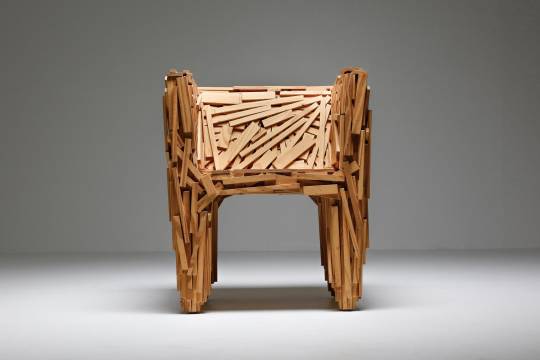


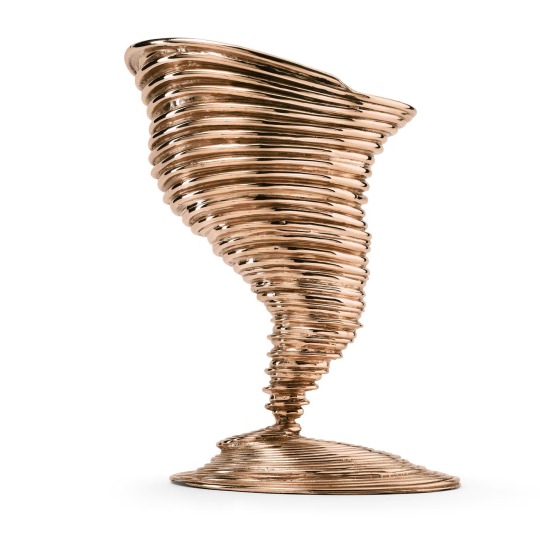

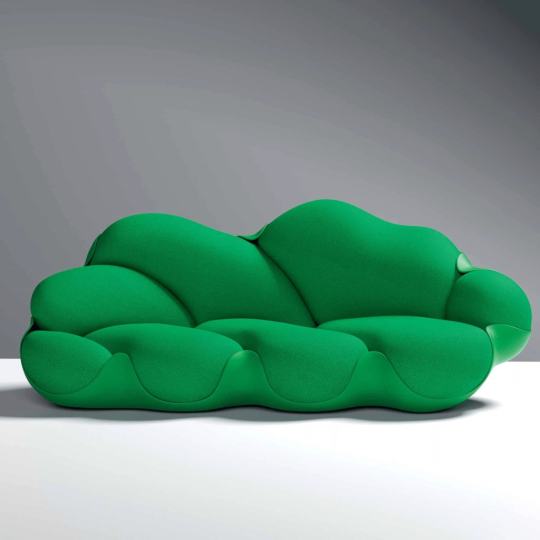




Fernando Campana (1961 – 2022)
Born in the rural town of Brotas, the São Paolo-based designer earned a degree in architecture from the Faculdade de Belas Artes de São Paolo in 1984, before creating Estudio Campana that same year with his older brother Humberto, an attorney.
During the 1980s the studio produced a series of sculptural metal chairs welded from iron called Desconfortáveis (Uncomfortables), eventually moving toward a practice using everyday materials like cardboard, rope, wicker, bamboo, and wood. Their iconic Favela Chair, from 1991 was fabricated with scraps of wood from discarded fruit crates, nailed and glued by hand. “The people who live in favelas construct their own homes, so I thought, why not construct a chair myself,” said Fernando in a discussion about the seat with curator Darrin Alfred from a 2010 interview. It was, he explained at the time, meant to symbolize a Brazilian shantytown.
It was in the 1990s—a time when the design world was primarily focused on the post-World War II movement of the Italians—that the Campanas came on the scene, with work that underscored Brazilian culture and its craft, sculpting furnishings from a range of raw and found materials. Their 1993 Vermelha Chair was a lesson in resourcefulness, hand-woven from cotton rope that enveloped a metal frame.
Design journalist Arlene Hirst was “gobsmacked” when she first encountered the chair, manufactured by Italian manufacturer Edra, at the Salone del Mobile in Milan. A year later the chair was included in Project 66: Campana Brothers/Ingo Maurer, a 1998 exhibition at The Museum of Modern Art (MoMA), curated by Paola Antonelli, the museum’s senior curator of architecture and design, an associate at the time. For this show, Antonelli paired the Brazilian brothers’ furniture with German lighting designer Ingo Maurer’s luminaires in vignettes that highlighted a shared passion for materiality and invention.
Both Fernando and Humberto were active in the production process as well, but as is often the case with partners, they remained elusive about specific roles. “Fernando had the training, so he was the more pragmatic one,” noted Antonelli in a recent interview, referring to his architectural roots. “He never discussed it. And I never questioned it. It was implied,” she said. The younger Campana also drew inspiration from his daily routines, local markets and wandering São Paolo’s streets. Antonelli recalled asking him about his use of found objects, asking if they weren’t too cute? His response, “They are not too cute. They are part of my life.”
Many of those found objects—including stuffed animals—made their way onto upholstered seating like the 2002 Banquete series, which became the equivalent of a sold-out Broadway show. It is still produced out of the Campana São Paolo studio, and handsewn by local craftspeople who are considered part of the extended Campana family.
In 2010 the New York- and L.A.-based gallery Friedman Benda began global representation of the brother’s work. “Campana Studio brought a completely fresh perspective, creating a dialogue with local crafts and the use of the readymade,” says co-founder Marc Benda, adding, “They were trailblazers.” The gallery assisted with support of the studio and helped them to balance the commercial success of their practice with its roots in the hand made.
One of the brothers’ last collaborations—presented in June at the 2022 Salone in Milan—is a collection called Metamorfosi, comprising five large-scale, pouf seats and a tapestry, created in collaboration with Italian textile designer Paola Lenti. Woven from remnants Lenti sorted and saved with CouLture Migrante, a social tailoring atelier (involving men and women asylum seekers residing in Como, Italy) the limited-edition pieces make their North American debut at Design Miami in December.
The work of Estudio Campana can be found at the Vitra Design Museum, Centre Pompidou, Musée Des Arts Décoratifs, MoMA, among other design-focused institutions. In 2020, they were the subject of 35 Revolutions, a retrospective at Museum of Modern Art, Rio de Janeiro on the occasion of their 35th anniversary.
Words by Melissa Feldman
Favela Chair for Edra, 2000, Pine, Height: 29.14 in (74 cm)Width: 26.38 in (67 cm)Depth: 24.41 in (62 cm)Seat Height: 15.75 in (40 cm),
Vermelha Armchair for Edra, 2019, Aluminium, Cord, natural cotton, Steel, 86 x 58 x h.77 cm,
Tornado Vase, Ghidini 1961, Bronze, W 11.81 x D 9.45 x H 14.57,
Jackfruit Table Lamp, Ghidini 1961, Polished Brass, Height: 19.69 in (50 cm), Diameter: 12.21 in (31 cm),
Bomboca Sofa GM, Objets Nomades, Louis Vuitton, 46.9 x 34.5 x 94.9 cm (18.5 x 13.6 x 37.4 in),
Bolotas Sofa (Cherry), 2019, Sheep’s wool, ipÊ, H: 95 W: 125 L: 215, Carpenters Workshop Gallery,
Edward Scissorhands side table, Giustini/Stagetti, 2014, Portorotype black marble and gilded bronze, 12 dia. x 22½ h in. (Casati Gallery),
Corallo Armchair for Edra S.p.A., Italy, 2004, Steel wire and epoxy paint, 38 x 60 x 39" (96.5 x 152.4 x 99.1 cm), Courtesy MoMa,
Sushi Buffet, 2012, Carpet, rubber, EVA, fabric and estela handcrafted into sushi rolls partially covering brass structure 28.25 x 78.75 x 17.75 inches (72 x 200 x 45 cm)
#art#design#furniture#lamp#vase#campana brothers#sofa#buffet#rubber#bronze#tornado#jackfruit#louis vuitton#edra#brazil#icon#legend#rip#bolotas#favela#chair#fernando campana#rip fernando campana
54 notes
·
View notes
Text

We are a professional manufacturing company with an independent design department and fabric R&D center. Our main focus is on researching and developing various scarves, kimonos, wraps, and other items in woven, knitted, printed, crochet, embroidery, sequins, etc.
2 notes
·
View notes
Text
Unveiling the Latest Advancements in Non-Woven Fabric Technology

Non-woven fabrics have revolutionized numerous industries with their versatility, durability, and eco-friendly properties. As a leading non-woven fabric manufacturer, Mavazi Fabrics is committed to staying at the forefront of technological advancements in this dynamic field. Let's explore some of the latest innovations shaping the landscape of non-woven fabric technology.
1. Sustainable Materials and Processes
In response to growing environmental concerns, non-woven fabric manufacturer are increasingly focusing on sustainable materials and processes. Innovations such as recycled fibers, bio-based polymers, and biodegradable additives are being incorporated into non-woven fabric production to reduce environmental impact and promote circularity. At Mavazi Fabrics, we embrace sustainable practices and offer a range of eco-friendly non-woven fabrics that meet the highest standards of environmental responsibility.
2. Enhanced Performance and Functionality
Advancements in non-woven fabric technology are leading to fabrics with enhanced performance and functionality. Manufacturers are developing fabrics with specialized properties such as moisture-wicking, antimicrobial, flame-retardant, and UV-resistant capabilities to meet the diverse needs of various industries. These advanced fabrics offer improved comfort, protection, and durability, making them ideal for applications ranging from healthcare and hygiene to automotive and construction.
3. Nanotechnology and Microfibers
Nanotechnology is revolutionizing the non-woven fabric industry by enabling the production of ultrafine fibers with unprecedented properties. Nanofibers exhibit superior strength, filtration efficiency, and surface area compared to conventional fibers, making them ideal for applications such as filtration, medical textiles, and protective apparel. Manufacturers are leveraging nanotechnology to develop non-woven fabrics with enhanced breathability, barrier properties, and filtration performance.
4. Smart and Intelligent Fabrics
The integration of smart and intelligent technologies is another exciting development in non-woven fabric technology. Manufacturers are incorporating sensors, conductive fibers, and microelectronics into non-woven fabrics to create smart textiles capable of monitoring vital signs, detecting environmental conditions, and transmitting data wirelessly. These smart fabrics have applications in healthcare, sports, military, and wearable technology, offering unprecedented levels of comfort, convenience, and functionality.
5. 3D Printing and Additive Manufacturing
Advancements in additive manufacturing technologies such as 3D printing are revolutionizing the production of non-woven fabrics. Manufacturers can now create complex fabric structures with precise control over fiber orientation, porosity, and thickness, allowing for the customization of fabrics according to specific requirements. 3D printing enables rapid prototyping, cost-effective production, and design flexibility, paving the way for innovative applications in fashion, aerospace, and consumer goods.
Conclusion
The latest advancements in non-woven fabric technology are driving innovation and opening up exciting possibilities across industries. From sustainable materials and enhanced performance to nanotechnology, smart fabrics, and additive manufacturing, non-woven fabric manufacturer like Mavazi Fabrics are at the forefront of these developments. By embracing cutting-edge technologies and pushing the boundaries of what is possible, we are proud to offer our customers innovative non-woven fabric solutions that meet the evolving needs of the market.
#nonwovenfabric#manufacturer#fabricmanufacturer#sustainabletextiles#textileindustry#ecofriendlymaterials#innovativefabrics#textiledesign#sustainablefashion#environmentallyfriendly#manufacturingindustry#nonwovenmaterials#supplychain#textileproduction#businessgrowth#industryinsights#sustainability#localbusiness#globalmanufacturing#fabricinnovation
3 notes
·
View notes
Photo


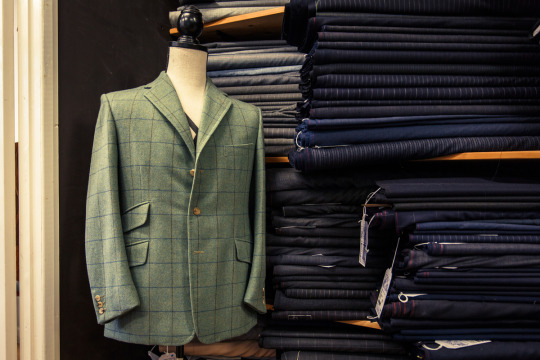
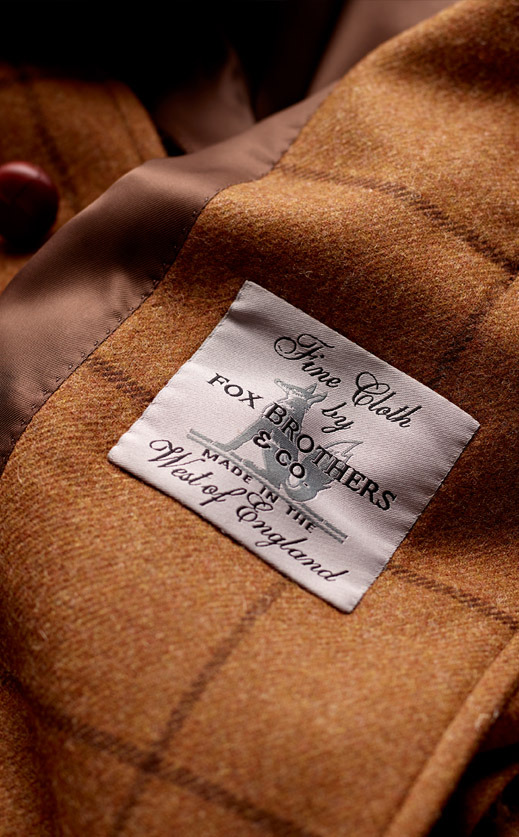
Fox cloth cuts like rich butter with tailors' shears and the dense, rich finish makes a superlative flannel suit.
- Simon Cundey, Henry Poole & Co
Legend has it, that when Sir Winston Churchill made his most memorable speeches in Parliament or on the BBC Radio he was clad in a suit cut from the finest West of England flannel, woven by his woollen mill of choice, the iconic Fox Brothers & Co.
Much like Churchill, Fox Brothers is a British institution of near national significance; at one time one of the largest and most prestigious woollen mills in the country, an employer to five thousand tradesmen, occupying a monumental site of several square miles, filled with the imposing red-brick towers and belching chimneys synonymous with good old Victorian industrialism in Wellington, Somerset.
Fox Brothers have been producing woollen and worsted fabric in Somerset since 1772, ie for the past two hundred and fifty years. Officially credited as the original creators of flannel, to this day we combine traditional manufacturing processes with state of the art design technology, to create the finest wool and cashmere cloth available in the world.
The mill's scale of production at its peak was quite frankly biblical; in 1914, with the outbreak of the First World War, the mill received the single largest textile order of the conflict, for 825 miles worth of khaki - a fabric which Fox Brothers can lay claim to having invented in 1901.
Sadly, such days are long behind many British manufacturers but fortunately today, Fox Brothers is experiencing a heart-warming renaissance and has returned to form as one of the finest producers of worsteds and woollen flannels in the United Kingdom.
In 2009, upon hearing that Fox was in dire straits, Douglas Cordeaux and his business partner Deborah Meaden, didn't think twice about running to the rescue and taking over Fox Brothers. Cordeaux was a menswear designer with a long history in luxury menswear and a passion for British heritage brands.
Thirteen years later, their brave decision and extraordinary vision has revitalised the mill and business now growing at a rate of knots - supplying cut lengths to the finest bespoke tailors and clothiers far and wide, and also weaving commercial orders for a huge number of international luxury brands; from Hackett to Aquascutum, Louis Vuitton and just about every single house on Savile Row.
Generations of men - and increasingly women - are grateful that Fox Bros have been the mainstay of their bespoke Savile Row suit or jacket. One of my woollen jackets from Huntsman carried the Fox Bros unshowy and understated label inside.
#simon cundey#henry poole & co#quote#fox bros#fox brothers#bespoke tailor#mill#cloth#woollen mill#savile row#history#british#english#icon#style#suit#elegance#heritage
42 notes
·
View notes
Text
Ventilated FIBC Bags
Alpine FIBC PVT.LTD. is a best manufacturer, exporters and suppliers of high quality Ventilated FIBC Bags & FIBC Ventilated Bags in India, USA, Germany, France, UK, Italy, Canada, Spain, Netherlands, Portugal, Greece, Sweden, Argentina, Chile, Poland. These Bags are specially designed to store food items like potatoes, onions etc. The ventilated fabric permits the required air flow through the fabric into the bag, thus preventing spoilage due to moisture and mold build-up. Usage of FIBC Ventilated Bags have eased the common supply chain issues of handling, storing and transporting food items, commonly witnessed with the 25/50 kg woven sack bags.
2 notes
·
View notes
Text
The Unsung Heroes of Comfort: Exploring the World of Socks

Introduction:
Socks: they're often the unsung heroes of our daily attire, quietly working to keep our feet warm, dry, and comfortable. Despite their humble appearance, socks play a crucial role in our everyday lives, offering both practical benefits and opportunities for self-expression. Let's dive into the fascinating world of socks and explore why they deserve more recognition than they often receive.
A Brief History: The history of socks dates back centuries, with early versions crafted from animal skins or woven fabrics. Throughout the ages, socks evolved alongside advancements in textile production and fashion trends. In ancient times, socks were primarily functional, providing warmth and protection for the feet during harsh weather conditions. However, as societies progressed, socks became symbols of status and style, adorned with intricate patterns and luxurious materials.
Practical Functionality: At their core, socks serve a practical purpose: to keep our feet comfortable and protected. Modern socks are designed with a variety of materials and features to address specific needs, whether it's moisture-wicking properties for athletes or extra cushioning for individuals on their feet all day. From cozy wool socks for winter to lightweight, breathable options for summer, there's a sock for every occasion and climate.
Health and Wellness: Beyond comfort, socks also play a vital role in maintaining foot health. Properly fitting socks can prevent blisters, chafing, and irritation, reducing the risk of foot-related ailments. Additionally, specialized socks with features such as arch support or seamless toes can offer relief for those with foot conditions like plantar fasciitis or diabetes. By providing a supportive barrier between the foot and shoe, socks contribute to overall foot wellness.
Fashion and Self-Expression: While functionality remains paramount, socks also serve as a canvas for self-expression. With an endless array of colors, patterns, and designs, socks offer a subtle yet impactful way to showcase personal style. Whether it's a bold statement sock peeking out from under a tailored suit or whimsical patterns adding flair to a casual outfit, socks allow individuals to inject personality into their attire. From novelty prints to sophisticated textures, there's no limit to the creativity found in the world of socks.
Environmental Considerations: In recent years, there has been a growing awareness of the environmental impact of clothing production, and socks are no exception. Sustainable sock brands are emerging, utilizing eco-friendly materials such as organic cotton, bamboo, or recycled fibers. Additionally, efforts to reduce waste and carbon emissions in the manufacturing process are becoming more prevalent. By choosing socks from environmentally conscious brands, consumers can minimize their ecological footprint without sacrificing quality or style.
2 notes
·
View notes